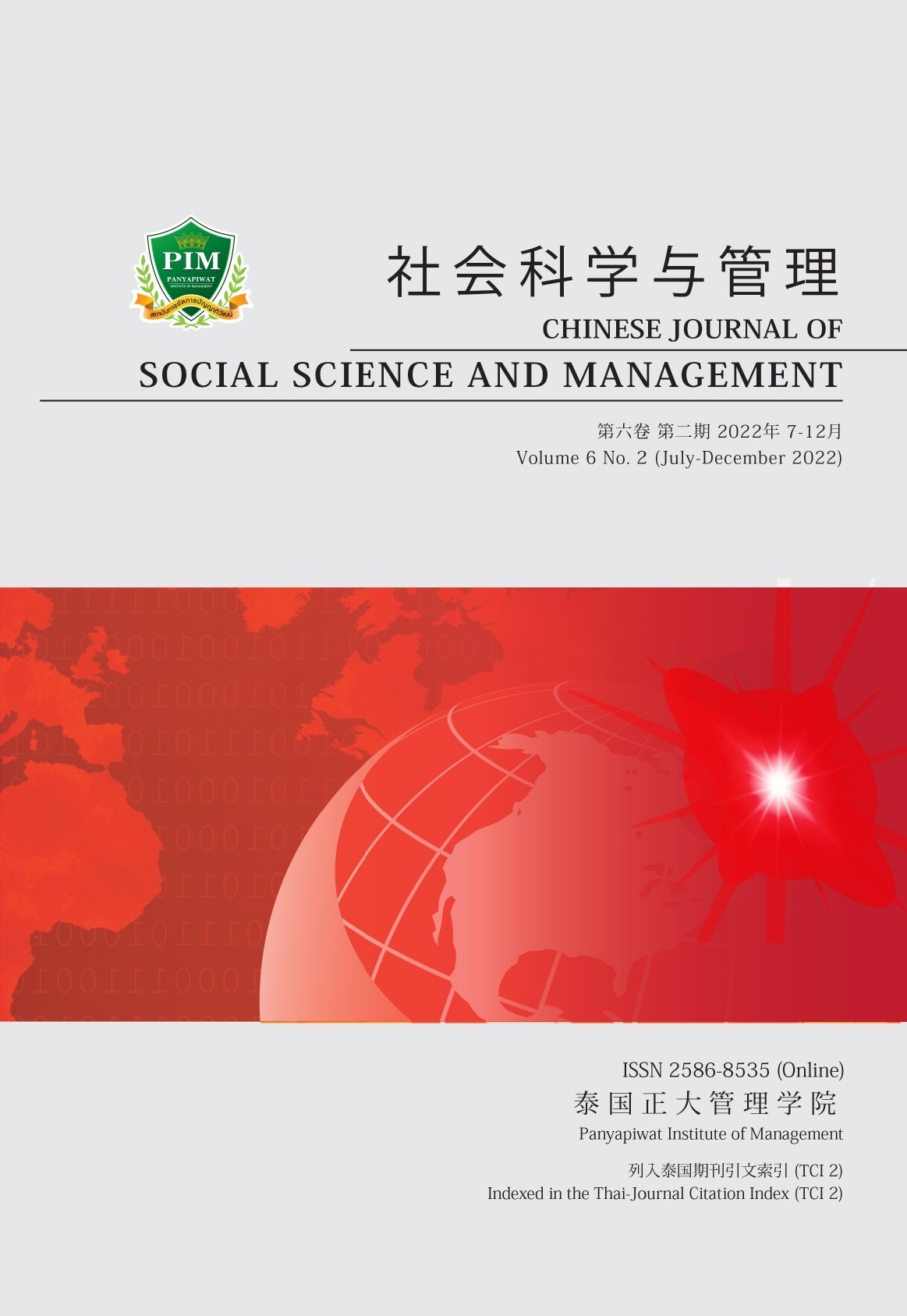FACTORS AFFECTING YOUNG CHINESE TOURISTS’ DECISION-MAKING ON TRAVELING TO THAILAND DURING COVID-19 PANDEMIC
Main Article Content
Abstract
The COVID-19 pandemic affects tourism industry in Thailand; consequently, Chinese tourists put off travelling to Thailand. The People of China has encouraged Chinese people to travel overseas; therefore, there was an increasing number of Chinese tourists in Thailand because Thailand has beautiful natural scenery. The great number of Chinese tourists are young. The researcher thinks that cultural backgrounds and lifestyles of young Chinese tourists are different from other groups, therefore, this
research aims to study the factors affecting travelling in Thailand of young Chinese tourists. This study promotes the development of tourism industry in Thailand and also provides a great insight for young Chinese tourists who are planning to travel in Thailand. The study is survey research. The random samples of this research were 302 young Chinese tourists who have visited Thailand. The instruments used was questionnaire which is designed based on the Marketing Theory of 4Ps. The questionnaire is related to food, accommodation, transportation, tour, shopping and entertainment. The data collected will help
researcher to analyze their feelings and experience including existing problems and impacts of young Chinese tourists during travelling. The data was analyzed by using SPSS 25. The description analyses included frequency analysis, percentages average, mean and regression analysis. The findings of this study found that factors such as transportation, economic conditions, food & beverage and entrainment, Thai local craft and products, shopping, affect young Chinese tourists’ decision making on traveling to Thailand were significantly related. In addition, this study also provides appropriate recommendation for improving the development of tourisms among young Chinese tourist travel to Thailand.
Article Details

This work is licensed under a Creative Commons Attribution-NonCommercial-NoDerivatives 4.0 International License.
Chinese Journal of Social Science and Management Editorial Division
The Office of Research and Development, Panyapiwat Institute of Management
85/1 Moo 2, Chaengwattana Rd., Bang Talat, Pakkred, Nonthaburi 11120, Thailand
Tel. 02 855 01048 E-mail: cjssm@pim.ac.th
References
Apinya, W. (2017). Study on the consumption behavior of Chinese self-help tourists in Huahin [Master’s thesis]. Minzu University of China. [in Chinese]
Atitayabhorn, P. (2019). The marketing mix (4Ps) and benefits of Online Travel Agency (OTA) in marketing promotions of the hotels in Nakhon Phanom Province. Journal of Thai Hospitality and Tourism, 14(1), 3-15. [in Thai]
Carr, N. (2002). A comparative analysis of the behavior of domestic and international young tourists. Tourism Management, 23(3), 321-325.
Du, J. D. (1999). On the adjustment of educational goal and the reform of curricular system for tourism management majors in the 21st century. Journal of Guilin Institute of Tourism, 2, 127-139. [in Chinese]
Global Health Security Index. (2021). 2021 GHS index country profile for Thailand. https://www.ghsindex.org/country/thailand/
International Living. (2022). The world’s best places to retire in 2022. https://internationalliving.com/the-best-places-to-retire/
Lei, J. (2012). A study of Chinese tourists’ behaviors in Thailand—A case of Chiang Mai Province. Sci-Tech & Development Enterprise, 12, 166-167. [in Chinese]
Lu, X. (2014). A comparative study on travel decision-making of young tourists between China and France [Master’s thesis]. East China University of Science and Technology. [in Chinese]
Namfon, C. (2013). Factors influencing the decision making of Chinese tourists travelling in Thailand. Journal of Southern Technology, 6(2), 53-60. [in Thai]
Philip, K., & Kevin, L. K. (2009). Marketing management. China Renmin University Press. [in Chinese]
Reisinger, Y., Mavondo, F., & Weber, S. (2001). The Australian and Croatian youth travel markets: Are they different. Tourism Culture and Communication, 3(2), 61-69.
Sangduen, R. (2012). Push and pull factors affecting Chinese tourists’ decision to travel to Thailand. Journal of Association of Private Higher Education Institutions of Thailand (APHEIT), 18(2), 85-104. [in Thai]
Schiffman, L. G., & Kanuk, L. L. (1994). Consumer behavior (7th ed.). Prentice-Hall.
Shi, Y. M. (2005). A study on shopping behaviors of tourists. Tourism Tribune, 5, 70-75. [in Chinese]
Siriwan, S. (1998). Organizational behaviour. Teerafilmm and Sytex Printing.
Su, Y. T. (2014). A study on the shopping behavior of Chinese tourists in King Power (Rangnum Rd.) duty free stores in Bangkok [Master’s thesis]. Kunming University of Science and Technology. [in Chinese]
Suchada, W. (2009). Foreign tourist’s expenditure behavior of buying products at Pattaya Floating Market. RMUTT. http://www.research.rmutt.ac.th/?p=3234 [in Thai]
Thailand Ministry of Tourism and Sports. (2015). Tourist Statistic of Thailand. https://www.mots.go.th/more_news_new.php?cid=411 [in Thai]
Therdchai, C. (2017). Expectations and satisfaction of Chinese tourists toward Thailand tourism management. Asia-Pacific Social Science Review, 16(3), 30-45.
Thosapol, D. (2010). Tourism products, responsible travel awareness and foreign tourist behavior in greater Mekong Sub-region. Srinakharinwirot University. [in Thai]
Thyne, M., Davies, S., & Nash, R. (2004). A segmentation analysis of the backpacker market in Scotland: A case study of the Scottish youth hostel association. Journal of Quality Assurance in Hospitality and Tourism, 5(3/4), 95-119.
U.S. News & World Report. (2021). Heritage. https://www.usnews.com/news/best-countries/rankings/heritage
World Tourism Organization. (2002). Youth outbound travel of the Germans, the British and the French. UNWTO.
Zikmund, W., & Michael, D. (2001). The power of marketing (7th ed.). South Western College.


